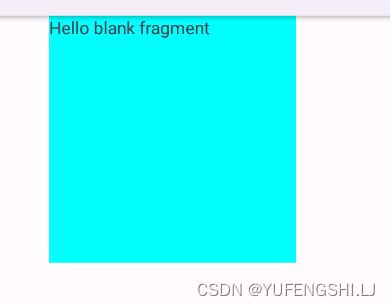Android Studio之Fragment
静态加载
直接在布局文件中完成配置,通过android:name属性指定 Fragement 的路径
1.在需要的布局(activity_fragment.xml)中添加fragment的控件
此时的添加的fragment控件没有样式
2.创建一个空的Fragment类,并删除这个新Fragment类中的多余代码只留 onCreateView(),Fragment创建视图时会调用这个方法
@Override
// onCreateView -> Fragment 创建视图时调用的方法
public View onCreateView(LayoutInflater inflater, ViewGroup container, Bundle savedInstanceState) {
// Inflate the layout for this fragment
// 将指定的布局文件填充到该Fragment的视图中,并返回该视图
// 使用LayoutInflater将布局文件转换为View对象,并将该View对象添加到指定的ViewGroup中。最后,它返回该View对象作为Fragment的视图
/* 注意!!
* LayoutInflater 的 inflate() 方法,它的作用是把xml 布局转换为对应的 View 对象
* findViewById则是从布局文件中查找一个控件*/
return inflater.inflate(R.layout.fragment_1, container, false);
}注意!LayoutInflater和findViewById的不同
LayoutInflater 的 inflate() 方法,它的作用是把 xml 布局转换为对应的 View 对象 ,而findViewById则是从布局文件中查找一个控件
3.在fragment类中绑定的布局文件中设置fragment样式(fragment_1.xml)
4.静态加载
利用fragment控件中的android:name=“……”属性指定fragment的路径。
动态加载
1.在布局文件中添加存放fragment的container,有一个专门的container:androidx.fragment.app.FragmentContainerView
2.在需要添加Fragment的布局文件对应的activity文件中添加以下代码:
- FragmentManager:用来管理Activity中的fragment
- FragmentTransaction:事务,用来添加,移除,替换fragment,
FragmentManager fragmentManager = getSupportFragmentManager();
FragmentTransaction fragmentTransaction = fragmentManager.beginTransaction();//开启事务
fragmentTransaction.add(参数1,参数2);
参数1:ViewGroup,即应放置片段的位置,由资源 ID 指定
参数2:要添加的片段(Fragment实例)
fragmentTransaction .add() ://往Activity中添加一个Fragment
fragmentTransaction .remove() ://从Activity中移除一个Fragment,如果被移除的Fragment没有添加到回退栈,
//这个Fragment实例将会被销毁。
fragmentTransaction .replace()://使用另一个Fragment替换当前的,实际上就是remove()然后add()的合体~
fragmentTransaction .hide()://隐藏当前的Fragment,仅仅是设为不可见,并不会销毁
fragmentTransaction .show()://显示之前隐藏的Fragment
fragmentTransaction .commit()://提交一个事务一旦通过 FragmentTransaction 做出了更改,就必须调用 commit() 以使更改生效。
package com.example.androidstudiostudy;
import androidx.appcompat.app.AppCompatActivity;
import androidx.fragment.app.FragmentManager;
import androidx.fragment.app.FragmentTransaction;
import android.os.Bundle;
// 创建一个新的activity 绑定布局 R.layout.activity_fragment ,在该布局里添加 fragment 控件,进行展示
public class FragmentActivity extends AppCompatActivity {
@Override
protected void onCreate(Bundle savedInstanceState) {
// 用Java代码添加fragment
FragmentManager fragmentManager = getSupportFragmentManager();
FragmentTransaction fragmentTransaction = fragmentManager.beginTransaction();
// 使用add()方法添加一个fragment片段
Fragment2 fragment2 = Fragment2.newInstance(null,null);
fragmentTransaction.add(R.id.fragment2,fragment2);
fragmentTransaction.commit();
}
}动态加载 - 替换Fragment
使用 FragmentTransaction.replace() 方法替换 Fragment
- 参数1:containerViewId 应放置片段的位置
- 参数2:要替换的片段
// FragmentTransaction.replace() 方法替换 Fragment
public void replaceFragment(View view) {
FragmentManager fragmentManager = getSupportFragmentManager();
FragmentTransaction fragmentTransaction = fragmentManager.beginTransaction();
Fragment1 newFragment = new Fragment1(); // 创建一个新的Fragment实例
fragmentTransaction.replace(R.id.fragment2,newFragment);
fragmentTransaction.commit();
}Activity向Fragment传值
利用Bundle来传递参数
1.实例化一个 fragment 对象
2.实例化一个Bundle对象
3.存入数据到Bundle对象中
4.调用Fragment 的 setArgument方法,传入 Bundle 对象
5.添加或者替换显示的Fragment
// 法一.通过Bundle来传递参数
public void commit(View view) {
/* 注意!! FragmentManager 和 FragmentTransaction 不能变成全局变量,会报错 */
FragmentManager fragmentManager = getSupportFragmentManager();
FragmentTransaction fragmentTransaction = fragmentManager.beginTransaction();
// 1.实例化一个 fragment 对象,注意这里实例化的不是
Fragment2 f2 = new Fragment2();
// 2.实例化一个Bundle对象
Bundle bundle = new Bundle();
// 3.存入数据到Bundle对象中
bundle.putString("AtoF1","这是activity向fragment传递的第一个消息");
// 4.调用Fragment 的 setArgument方法,传入 Bundle 对象
f2.setArguments(bundle);
// 5.添加或者替换显示的Fragment
fragmentTransaction.replace(R.id.fragment2,f2);
fragmentTransaction.commit();
}在fragment类获取数据
@Override
public View onCreateView(LayoutInflater inflater, ViewGroup container, Bundle savedInstanceState) {
// Activity 向 Fragment 传值 - getArguments() 得到传回来的值,返回的实际是一个 Bundle
Bundle bundle = getArguments();
// 和Activity之间传值一样,是什么类型就get什么类型
String msg1 = bundle.getString("AtoF1");
// 根据布局id得到视图
View v = inflater.inflate(R.layout.fragment_2, container, false);
// 设置视图
TextView textView = v.findViewById(R.id.textView2);
textView.setText(msg1);
// 返回设置好的视图
return v ;
}利用环境上下文
利用Activity 和 Fragment二者相互关联,可以相互获取对方的对象这一特性。利用环境上下文可以访问到对方的方法
在宿主activity中定义方法,定义要传递的值
// 法二.利用context环境上下文 和 onAttach ,在 Fragment1中获取数据
/* 在 Activity 和 Fragment 建立关系的时候,onAttach 方法会得到环境上下文 context,根据这个context可以获取宿主activity的方法和变量*/
public String getTitles(){
return "这是通过环境上下文 和 onAttach 进行传值的";
}
在对应Fragment的onAttach方法中,将当前环境变量强转成宿主Activity,从而访问到刚刚宿主activity定义的方法,获取数据
@Override
public void onAttach(@NonNull Context context) {
Log.d("FragmentLife","onAttach-----Fragment与activity关联");
// 强转成宿主activity
String msg = ((FragmentActivity)context).getTitles();
Toast.makeText(context,msg,Toast.LENGTH_SHORT).show();
super.onAttach(context);
}Fragment向activity传值 - 利用接口
- 定义一个接口,在这个接口中声明一个用于传递数据的方法
- 让 接收数据的activity实现该接口,然后重写回调方法,目的:获取传入的值并做处理
- 在自定义fragment中,声明一个回调接口的引用
- 在onAttach()方法中,为第三步的引用赋值(可以把activity的对象赋值给它)
- 用引用调用传递数据的方法,本质上调用的是activity中的那个方法,此时就可以把数据传递进去
本质是:在 Fragment 中定义接口和传递参数的方法,在activity中实现接口并重写接口中的方法
在 Fragment 中的声明一个回调接口的引用,因为 Activity 实现了 CommitData 接口的,所以可以将 Activity 转换为 CommitData 类型的对象
在 onAttach 方法中获取这个对象,并调用其中的方法并传入数据
Fragment类
// 1.定义一个接口,在这个接口中声明一个用于传递数据的方法
public interface CommitData{
public void sedMSG(String msg);
}
// 3.在自定义fragment中,声明一个回调接口的引用
private CommitData commitData;
@Override
// 4.在onAttach()方法中,为第三步的引用赋值(可以把activity的对象赋值给它)
public void onAttach(@NonNull Context context) {
super.onAttach(context);
// 获取到的 Activity 对象强制转换为 CommitData 接口类型的对象,
// 因为 Activity 实现了 CommitData 接口的,所以可以将其转换为 CommitData 类型的对象
commitData = (CommitData) getActivity(); // 注意强转
commitData.sedMSG("传递的");
}接收数据的activity类
实现接口重写回调方法
public class FragmentActivity extends AppCompatActivity implements Fragment2.CommitData{
@Override
// 2.让 接收数据的activity实现该接口,然后重写回调方法,目的:获取传入的值并做处理
public void sedMSG(String msg) {
TextView textView = findViewById(R.id.showData);
textView.setText("传回的数据:"+msg);
}
